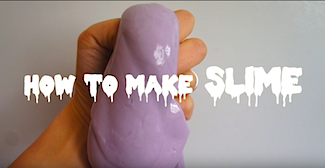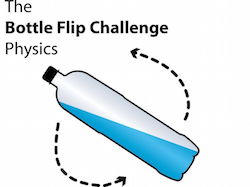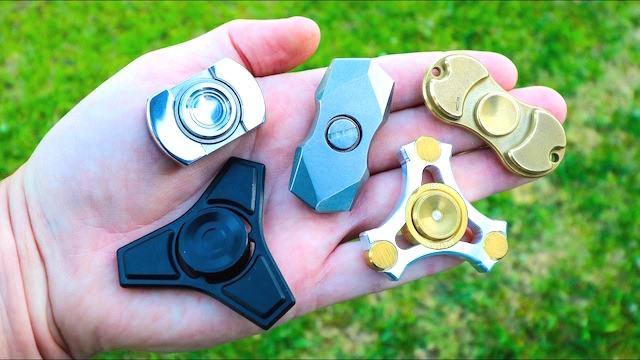Flipping, Spinners & Slime: Those Crazy Middle School Fads

The 2016-2017 school year will be burned into my memory as The Year of the Fad.
To be accurate, there are always fads in middle school. Most of the time they are fashion related, like the white Adidas sneakers with black stripes that became required apparel last spring for the girls.
Sometimes they are charming. Remember the rainbow loom craze of about three years ago where kids crafted bracelets out of colorful rubber bands – a trend that pulled children away from screens as they mastered complicated weaving patterns?
But occasionally, like in 2016-2017, the fads are neither fashion-related nor charming. They are just annoying.
Not for the children, of course, who embrace each passing fancy with a zeal we wish they brought to their school work, but annoying for the teachers who are at the mercy of whatever whimsy captivates their students’ attention.
First it was bottle flipping…
Bottle flipping was the first craze of the year. For those not in the know, bottle flipping is a game where a water bottle filled with just the right amount of fluid is flipped so that it lands upright. This feat takes considerable skill, and there have been many, many youtube videos created on the art of the flip.
I barely noticed my own seventh grader practicing the flip at home in the first few weeks of September, and thought it coincidental that the kids in the cafeteria at my school were playing the same game. But as friends from various parts of my densely populated county told me their middle schoolers were also flipping, I realized we were knee deep in the latest middle school mania.
If this particular trend had confined itself to the cafeteria, it might have had a longer shelf life. But bottles began flipping during class, when students believed the teacher’s back was turned. What the children did not realize is that when a bottle lands upright, or upside down, it makes a sound, and triggers all the poorly stifled giggles that accompany the game.
By October, when custodians started complaining that water was being spilled, and teachers complained of losing their sanity at too early a date in the year, the flip was banned, and not just at my school. RIP bottle flipping – you will not be missed.
It left a slimy trail
Next the students opted for a quieter trend, one that didn’t make noise so much as it made a mess. Slime. Created in mom’s kitchen with Elmer’s Glue, shaving cream and saline solution, this silly putty like substance hit the middle school scene sometime around November.
Children began toting it off to school in airtight containers and zip lock baggies to share with 300 of their closest friends. Although this didn’t happen at my middle school, I heard that it was actually being sold by budding entrepreneurs (hope for the future!) at other schools. I guess some parents would not allow their kitchens to be turned into a slime factory.
At schools across America (we have to assume) remnants were caked onto classroom floors and tables, and pieces were divided up and passed around class like hor d’oeuvres at a cocktail party.
Zen and the art of fidget spinning
Just before we outlawed the slime, spring hit, and slime went splat. Teachers were grateful until we learned what caused the hasty exit of the goo.
Enter the school year’s most disruptive fad – the fidget spinner – a hand-held device (allegedly) meant to help students focus by placing a finger into the center and spinning the gadget to produce a feeling of zen contentment.
I have heard that these have become quite popular among adults as well, although I doubt any of the grown-up consumers are teachers. These small contraptions are anything but zen in a classroom. Fingers spin, heads twirl, and hands grab.
All of a sudden each of my 100 pupils has self diagnosed ADHD and must spin. (There are event training films.)
And if one does not own a spinner, then one must watch thy neighbor spin, instead of watching thy teacher teach. At some point when participating as a spectator becomes dull, one must procure a spinner by grabbing thy neighbor’s, who will, of course, stop spinning in order to move the gadget out of harm’s way, which usually results in an altercation. Even with thy teacher.
Some of my colleagues have declared their rooms fidget-free zones. As for me, I have a desk full of spinners by noon, but the owners never forget to reclaim them on the way out – and are far more likely to return the next day with a spinner than a pencil.
Fads will always be with us
Fads come with the territory when you teach middle school. They sop up all that elusive “student engagement” we seek by diverting their attention away from the task at hand, however interesting.
They frustrate, exasperate and occasionally enrage the adults, creating a quasi us-versus-them atmosphere as we share our desperation and exasperation at competing with inanimate objects for attention.
But what can we really do? From an early adolescent anthropological and psychological perspective, fads fascinate.

But the fads could also indicate the underlying insecurity that most 11-14 year olds feel. Kids this age simultaneously want attention and don’t want attention. One of my students shared this insight:
Someone brings the toy to school, and everyone wants to see it, which makes him or her cool. Since everyone wants attention, other kids go buy the toy. But then, more kids have the item, so nobody gets attention, but then you still have to have one, because if you don’t, you are different, and not so cool.”
Confusing. Just like middle school, where the lines of what constitutes social acceptance are indistinct and always being redrawn.
Fidget spinners, slime, skillful flipping – whatever the latest and greatest is – gives the owner kid currency, a way to obtain peer approval by having something to offer, and a way to fit into the crowd. No kid at this age thinks they “own” cool, but if the group is spinning or sliming or flipping, well, then, he or she better jump on board.
Fads can be teachable moments
Fads, like middle school, are a moment in time. They are usually quirky, just like our kids. They are also quickly forgotten in favor of a more novel custom. But if the kids can gain currency by embracing the latest whim, perhaps so can we.

So as quickly as these fads enter and exit the scene, we the teachers must grab hold of the new thing, somehow maintain our own sanity and classroom control, and join them for the moment in time. It’s our currency, really, with them. And if we can’t beat them, we might as well join them!
____________
Laurie Lichtenstein has been teaching 7th and 8th grade English and Social Studies in Westchester County, NY for the better part of two decades. In whatever spare time she can scrounge up, she writes about education and parenting her three children. Her work can be seen in Motherwellmag.com, the Bedford Patch, and The Times of Israel. You can follow her on Twitter @thriceblessed. She last wrote for MiddleWeb about the enduring pull of The Outsiders to every generation of adolescents.
































I can honestly say the fidget spinner has been the best thing to happen to my 6th grader since he started school seven years ago. He jumped on the fad early in February by making a concept from a YouTube video, got a nudge from an Ed Tech teacher/consultant to take it to the next level of prototype and visit the Maker Space, Think[box] at Case Western Reserve University.
When I pulled into the parking lot at CWRU, my son ran into the building with a huge smile. From that point on, he’s learned to use laser cutters, 3D printers, 3D Modeling software, and much more. Now he has his own 3D printer where he’s able to produce his own version of the fidget spinner. He’s supplied a local boutique with three orders of fidget spinners and has sold more than 250 spinners over all…all because a forward-thinking teacher saw him playing wth a crude, zip-tie, first generation fidget spinner. This Generation Z is embracing and owning their learning.